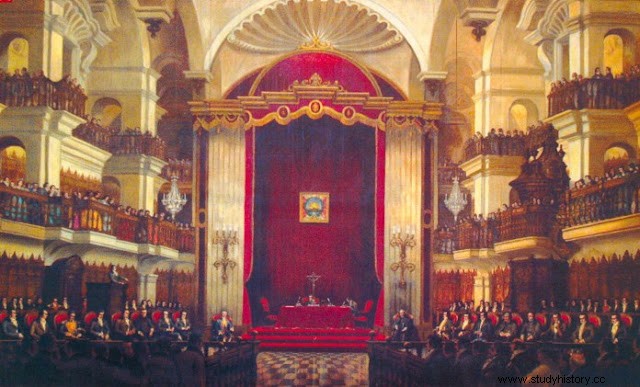1. First Constitution of 1823 As soon as the Independence of Peru was proclaimed, a Constituent Congress was installed in Lima with great pomp and solemnity, on September 20, 1822, convoked by General San Martín and made up of proprietary deputies elected by the free departments and substitutes appointed by those who still they were not. This Congress sanctioned the first Political Constitution in November 1823, with a provisional nature until, after the war, a general Congress met with deputies elected by all the peoples of the nation.
 First Constituent Congress of Peru of 1822 (painting by Francisco González Gamarra) 2. The boliviana or life of 1826 When the time came, the General Congress was effectively summoned for February 1826; but, it was not installed, because 52 deputies who constituted the majority, and who are known in our history by the nickname of Persians, exaggerating the difficulties of the situation, believed it more obvious to advise the adoption of a plebiscite, which resulted in the Constitution called Boliviana, in which Bolívar was conferred power for life.
First Constituent Congress of Peru of 1822 (painting by Francisco González Gamarra) 2. The boliviana or life of 1826 When the time came, the General Congress was effectively summoned for February 1826; but, it was not installed, because 52 deputies who constituted the majority, and who are known in our history by the nickname of Persians, exaggerating the difficulties of the situation, believed it more obvious to advise the adoption of a plebiscite, which resulted in the Constitution called Boliviana, in which Bolívar was conferred power for life.3. The one from 1828 The duration of the Constitution of 1826 was ephemeral; a military insurrection brought down the presidency for life; and in 1827 a Constituent Congress was installed, which sanctioned the Constitution of 28, reducing the presidential term to four years.
4. The one from 1834 Those legislators must have been unsure of their work [1828], when they limited its duration to five years, disposing at the same time that in 1833, a Convention would meet to examine and reform it. It came, in effect, and, annulling the previous one, gave the Constitution of 1834. Unlike the Congress of 1828, the Convention wanted, with difficulty the reform, to ensure long life to its Charter; But the opposite happened; The Assembly was violently dissolved, civil war ignited in the country and after bloody incidents, we saw our territory already severed by Bolívar split up, and the Peru-Bolivian Confederation established in 1836, with General Santa Cruz as supreme protector.
5. The Huancayo of 1839 Three years later, the battle of Ancash, won by General Gamarra, one of the greatest captains in South America, overthrew the protector forever and restored national unity; moreover, disregarding the Charter of 1934, which perhaps did not please him, he preferred to convene a Congress, which, together in Huancayo, sanctioned the Constitution of 1839.
6. The one from the year 1856 This authoritarian Charter [referring to the one of 1839], which annulled the autonomy of the municipalities, establishing police departments subject exclusively to the Government and conferring broad powers on it, could not counteract the aspirations of the people, nor the current of ideas . Thus it was that its reform was longed for when the revolution of 1854 broke out; and victory achieved, the National Convention was convened, which gave the liberal Constitution of 1856. As in 1834, the Assembly was violently dissolved; and as then, the country was involved in civil war. The Constitution did not come into full force, due to the fear inspired by the departmental boards, with administrative and political powers; and the radical reforms that were implanted in it were badly received:by the clergy, who had been disbarred; by the army, whose promotions were difficult; by the Government, which saw its powers limited; for the employees, who lost ownership of their destinies; and in general, by the enemies of all innovation.
7. The Constitution of 1860 The desire to reform the Charter was manifested, then, of course; And the decisive blow was struck by the thoughtless conduct of the Congress of 1858, which with indiscreet, though just zeal, got involved in the question of the vacancy of the presidency and put the Government in a great embarrassment. Putting the Chambers in temporary recess, the Government prevented his reinstatement, convening a new Congress for July 28, 1860. At that time there was a man of vast visions, sweet and friendly exterior, firm and tenacious character, clear intelligence, varied education , easy and traditional diction; This man, who was none other than Dr. Bartolomé Herrera, had been working tirelessly to make the sovereignty of the most intelligent triumph and to endow his country with a strong, aristocratic government. Severely wounded by the ecclesiastical lawlessness and counting on a competent number of distinguished disciples who will help him, he believed that the opportune moment had arrived to carry out his plans, he reached an understanding with the Ministry and the constitutional reform was agreed upon, through a plebiscite that authorized the representatives to take it carried out before dividing into Chambers. This is what happened in effect and the liberal cause seemed lost, since in the first vote we were barely thirteen; but, this small group increased day by day and fought vigorously until achieving victory on the two main points, which had motivated the reform, namely the jurisdiction and re-election, on which all efforts were concentrated. Since it was decided to maintain the personal immunity, the Reverend Bishop Herrera, president of Congress, stopped attending the sessions, then left the capital, seeing his work of twenty years fail, and retired to his diocese, where he soon died of bitterness. of disappointment; and confirmed the non-reelection, General Castilla stepped down from command, thus achieving for the Congress what the arms had tried in vain.
Taken from the Constitutional Law Course (Center for Constitutional Studies, 2015) of the distinguished jurist José Silva Santisteban.
